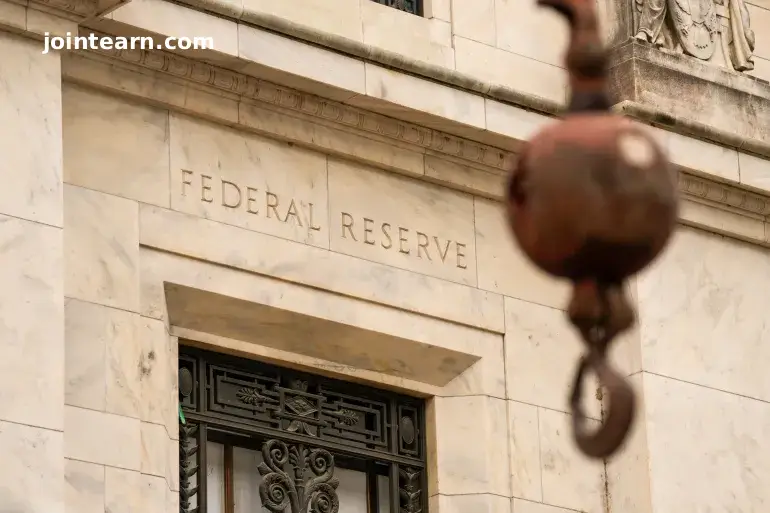
The Fed lowers its benchmark rate for the second time in 2025, citing cooling job growth and persistent inflation pressures.
Washington, D.C. – October 29, 2025
The United States Federal Reserve has reduced its benchmark interest rate by 25 basis points, bringing the federal funds rate range to 3.75–4.00 percent. The decision, announced Wednesday, marks the second rate cut of 2025 as policymakers respond to signs of a slowing labour market, faltering consumer confidence, and persistent inflationary pressures.
A Balancing Act Between Inflation and Growth
In its post-meeting statement, the Federal Reserve said the U.S. economy continues to face uncertainty amid mixed economic indicators.
“Job gains have slowed this year, and the unemployment rate has edged up but remained low through August. Inflation has moved up since earlier in the year and remains somewhat elevated,” the Fed said.
While inflation remains above the central bank’s 2 percent target, slowing job creation and a weakening economic outlook have prompted the Federal Open Market Committee (FOMC) to ease policy. The cut was widely anticipated, with CME FedWatch data showing a 97.8 percent probability of a reduction ahead of the announcement.
Economists at Goldman Sachs, Citigroup, HSBC, and Morgan Stanley had predicted an additional 25-basis-point rate cut before the end of the year. Only Bank of America Global Research projected no further reductions in 2025.
Powell: No Decision Yet on December Rate Move
Speaking at a press conference following the announcement, Federal Reserve Chair Jerome Powell stressed that another cut in December is not guaranteed.
“We haven’t made a decision about December,” Powell said. “We remain well-positioned to respond in a timely way to potential economic developments.”
Powell emphasized the Fed’s cautious approach, noting the need to support job growth without reigniting inflation. Analysts say this stance reflects the Fed’s effort to strike a balance between stimulating economic activity and preserving price stability.
Impact of the Government Shutdown
The latest decision comes amid an ongoing U.S. government shutdown, now in its 29th day — the second-longest shutdown in U.S. history, behind the 35-day closure during former President Donald Trump’s first term in 2018–2019.
The shutdown has disrupted the release of crucial government data, complicating the Fed’s decision-making process. The Department of Labor has been unable to publish the September jobs report, while other economic indicators have been delayed.
Only the Consumer Price Index (CPI) was released this month, showing a 0.3 percent monthly rise and a 3 percent annual inflation rate. The data was issued because it is required for calculating Social Security cost-of-living adjustments (COLA) for 2026, which will rise by 2.8 percent.
Powell acknowledged the data gap, saying the central bank will rely on private sector indicators and alternative data to monitor the economy.
“We are not going to have the detailed feel of things, but if there were a significant or material change in the economy one way or another, I think we would pick that up,” he said.
Signs of a Weakening Labour Market
Private trackers and corporate reports show clear signs of a cooling job market. Several major U.S. companies have announced mass layoffs in recent weeks.
- Amazon eliminated 14,000 corporate jobs.
- Paramount Global cut 2,000 employees on Wednesday.
- Target laid off 1,800 workers last week.
These corporate reductions, combined with furloughs of federal workers during the shutdown, are amplifying uncertainty in the job market. The U.S. government remains the nation’s largest employer, magnifying the impact of prolonged disruptions.
Consumer Confidence Hits a Six-Month Low
The Conference Board’s Consumer Confidence Index, released Tuesday, fell to its lowest level in six months. The decline was most pronounced among households earning less than $75,000 annually, who expressed heightened fears over job stability and rising costs.
Higher-income consumers — particularly those earning over $200,000 a year — remain more optimistic and continue to drive spending, sustaining the broader economy. Economists warn, however, that confidence could erode further if layoffs continue and inflation remains sticky.
Market Reaction to the Fed’s Move
U.S. financial markets responded cautiously to the rate cut. By mid-afternoon trading in New York, the S&P 500 and Dow Jones Industrial Average were each down about 0.3 percent, while the Nasdaq Composite remained flat.
Analysts interpret the mild reaction as a sign that markets had already priced in the decision. Investors are now looking ahead to the Fed’s December policy meeting for clarity on the trajectory of interest rates heading into 2026.
The Road Ahead for the Federal Reserve
The Fed’s latest move underscores a growing challenge: managing the competing risks of economic slowdown and stubborn inflation. Some analysts argue that while rate cuts can help sustain job growth, they also risk reigniting price pressures if consumer demand rebounds too quickly.
“The Fed has a challenging line to walk — lower interest rates to support labour markets and growth, or raise them to tamp down inflation,” said Michael Klein, professor of international economic affairs at Tufts University’s Fletcher School. “For now, they are taking a cautious approach tilted toward growth concerns.”
As policymakers navigate a murky outlook clouded by the government shutdown and inconsistent data, the coming months could determine whether the Fed’s soft-landing strategy succeeds or whether more aggressive moves will be needed in 2026.


Leave a Reply